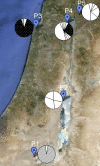Population-genetic analysis of HvABCG31 promoter sequence in wild barley (Hordeum vulgare ssp. spontaneum)
- PMID: 23006777
- PMCID: PMC3544613
- DOI: 10.1186/1471-2148-12-188
Population-genetic analysis of HvABCG31 promoter sequence in wild barley (Hordeum vulgare ssp. spontaneum)
Abstract
Background: The cuticle is an important adaptive structure whose origin played a crucial role in the transition of plants from aqueous to terrestrial conditions. HvABCG31/Eibi1 is an ABCG transporter gene, involved in cuticle formation that was recently identified in wild barley (Hordeum vulgare ssp. spontaneum). To study the genetic variation of HvABCG31 in different habitats, its 2 kb promoter region was sequenced from 112 wild barley accessions collected from five natural populations from southern and northern Israel. The sites included three mesic and two xeric habitats, and differed in annual rainfall, soil type, and soil water capacity.
Results: Phylogenetic analysis of the aligned HvABCG31 promoter sequences clustered the majority of accessions (69 out of 71) from the three northern mesic populations into one cluster, while all 21 accessions from the Dead Sea area, a xeric southern population, and two isolated accessions (one from a xeric population at Mitzpe Ramon and one from the xeric 'African Slope' of "Evolution Canyon") formed the second cluster. The southern arid populations included six haplotypes, but they differed from the consensus sequence at a large number of positions, while the northern mesic populations included 15 haplotypes that were, on average, more similar to the consensus sequence. Most of the haplotypes (20 of 22) were unique to a population. Interestingly, higher genetic variation occurred within populations (54.2%) than among populations (45.8%). Analysis of the promoter region detected a large number of transcription factor binding sites: 121-128 and 121-134 sites in the two southern arid populations, and 123-128,125-128, and 123-125 sites in the three northern mesic populations. Three types of TFBSs were significantly enriched: those related to GA (gibberellin), Dof (DNA binding with one finger), and light.
Conclusions: Drought stress and adaptive natural selection may have been important determinants in the observed sequence variation of HvABCG31 promoter. Abiotic stresses may be involved in the HvABCG31 gene transcription regulations, generating more protective cuticles in plants under stresses.
Figures






References
-
- Wright SI, Gaut BS. Molecular population genetics and the search for adaptive evolution in plants. Mol Biol Evol. 2005;22:506–519. - PubMed
-
- Raven JA, Edwards D. In: The evolution of plant physiology: from whole plants to ecosystems. Alan R, editor. Amsterdam: Elsevier; 2004. Physiological evolution of lower embryophytes: adaptations to the terrestrial environment; pp. 17–41.
Publication types
MeSH terms
Substances
Associated data
- Actions
- Actions
- Actions
- Actions
- Actions
- Actions
- Actions
- Actions
- Actions
- Actions
- Actions
- Actions
- Actions
- Actions
- Actions
- Actions
- Actions
- Actions
- Actions
- Actions
- Actions
- Actions
LinkOut - more resources
Full Text Sources

